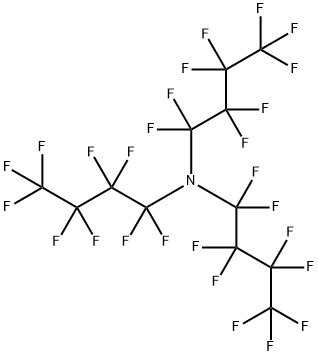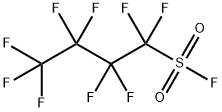Potassium heptadecafluoro-1-octanesulfonate
Synonym(s):Perfluorooctanesulfonic acid potassium salt;Potassium heptadecafluoro-1-octanesulfonate
- CAS NO.:2795-39-3
- Empirical Formula: C8F17KO3S
- Molecular Weight: 538.22
- MDL number: MFCD00066407
- EINECS: 220-527-1
- SAFETY DATA SHEET (SDS)
- Update Date: 2025-01-27 09:38:02

What is Potassium heptadecafluoro-1-octanesulfonate?
Chemical properties
Brown solid
The Uses of Potassium heptadecafluoro-1-octanesulfonate
Potassium heptadecafluoro-1-octanesulfonate is a persistent environmental pollutant that may cause adverse health effects in humans.
The Uses of Potassium heptadecafluoro-1-octanesulfonate
Perfluorinated surfactants consist of a broad class of fluorinated chemicals of differing structures, physical–chemical properties, and modes of toxic action. This class of compounds is made up of fully fluorinated organic compounds that due to their unique chemical properties can be used in a variety of industrial processes and products. Some characteristics of these chemicals are the ability to repel water and oil, reduce surface tension, catalyze oligomerization and polymerization, and maintain their properties under extreme conditions. Sulfonyl-based perfluorochemicals are produced by an electrochemical fluorination (ECF) process where hydrogen atoms of a feedstock are replaced with fluorine atoms. Perfluorooctane sulfonyl fluoride (POSF) is the principal product from this process and it has been used in a variety of products that can be divided into three main categories: surface treatments (carpet and textile protection), paper protection (grease, oil, and water resistance), and performance chemicals (firefighting foams, mining surfactants, and electronic etching baths). Depending on the degree of derivatization and polymerization, POSF products can degrade to perfluorooctane sulfonate (PFOS), a stable end product that is resistant to degradation. Commercially, ECFproduced PFOS consists of linear (70%) and branched (30%) isomers that have differing environmental and toxicological properties. However, due to the presence of PFOS in biota from sites remote from production, as well as its presence in human blood, PFOS has been voluntarily withdrawn from commercial production in the United States. In Europe, the use of PFOS is regulated by Registration, Evaluation, Authorisation and Restriction of Chemical (REACH) under Annex XVII.
Environmental Fate
As a result of the production and use of PFOS and its precursors, it has been released into the environment through variety of waste streams. The environmental partitioning behavior of PFCs is unusual and differs from many other persistent organic pollutants in that PFOS-based substances are both oleophobic and hydrophobic. As a result, an octanol/water partitioning coefficient (Kow) for PFOS has not been determined. PFOS is persistent in the environment and does not hydrolyze, undergo direct or indirect photolysis, or biodegrade to any significant degree. While PFOS has low volatility, several PFOS precursors are considered volatile, including EtFOSE and N-methyl perfluorooctane sulfonamidoethanol alcohols, which may account for its global distribution. As a result of its persistence and widespread distribution, PFOS was recently added to the Stockholm Convention’s list of persistent organic pollutants. If released into soil, sediment, or sludge, PFOS is expected to adsorb strongly to organic and inorganic components. Due to these properties, PFOS is expected to persist in soils, sediments, and sludge. If released into water, PFOS is expected to remain in the water compartment unless it is assimilated into organisms or adsorbed onto particulate matter and potentially deposited into sediments. Volatilization from water surfaces or biodegradation is not expected to be important fate processes. PFOS has the potential to bioaccumulate in aquatic organisms. Laboratory-based bioconcentration factors for PFOS range from 56 to over 1000 while field-based bioaccumulation factors range from 830 to 125 000. The field-based bioaccumulation factors for PFOS may be overestimated due to metabolism of accumulated perfluorinated derivatives of PFOS. Trophic magnification of PFOS in food webs has also been studied in several different aquatic systems. In a bottlenose dolphin food web, the trophic magnification factor (TMF) based on whole body concentrations ranged between 1.8 and 6.3. In an Eastern Arctic marine food web with glaucous gulls as the top predator, the TMF for PFOS was 3.1 while in a Western Canadian Arctic food web the TMF was 1.9. Finally, in a Lake Ontario food web, the TMF for PFOS was 3.8. In a terrestrial environment that examined a food chain that included lichen–caribou–wolf, the TMF for PFOS ranged from 2.3 to 2.6. Overall these results indicate that PFOS is magnified up through different trophic levels in both aquatic and terrestrial food webs.
Toxicity evaluation
The mechanisms governing the toxicity of PFOS to biological systems are still under investigation. Potential modes of action that have been identified include competition with fatty acids for carrier protein sites, cholesterol synthesis, and bioenergetics. Other studies suggest that PFOS may alter peroxisomal fatty acid b-oxidation.
Properties of Potassium heptadecafluoro-1-octanesulfonate
| Melting point: | 277-280 °C(lit.) |
| Density | 1.1 |
| solubility | Methanol, Water (Slightly, Heated, Sonicated) |
| form | Powder |
| color | white |
| BRN | 3864579 |
| Stability: | Hygroscopic |
| InChI | InChI=1S/C8HF17O3S.K/c9-1(10,3(13,14)5(17,18)7(21,22)23)2(11,12)4(15,16)6(19,20)8(24,25)29(26,27)28;/h(H,26,27,28);/q;+1/p-1 |
| CAS DataBase Reference | 2795-39-3(CAS DataBase Reference) |
| EPA Substance Registry System | Potassium perfluorooctanesulfonate (2795-39-3) |
Safety information for Potassium heptadecafluoro-1-octanesulfonate
| Signal word | Danger |
| Pictogram(s) |
 Skull and Crossbones Acute Toxicity GHS06  Health Hazard GHS08  Environment GHS09 |
| GHS Hazard Statements |
H301:Acute toxicity,oral H332:Acute toxicity,inhalation H351:Carcinogenicity H362:Reproductive toxicity, effects on or via lactation H372:Specific target organ toxicity, repeated exposure H411:Hazardous to the aquatic environment, long-term hazard |
| Precautionary Statement Codes |
P201:Obtain special instructions before use. P260:Do not breathe dust/fume/gas/mist/vapours/spray. P263:Avoid contact during pregnancy/while nursing. P273:Avoid release to the environment. P301+P310:IF SWALLOWED: Immediately call a POISON CENTER or doctor/physician. |
Computed Descriptors for Potassium heptadecafluoro-1-octanesulfonate
| InChIKey | WFRUBUQWJYMMRQ-UHFFFAOYSA-M |
| SMILES | C(F)(F)(C(F)(F)C(F)(F)C(F)(F)S([O-])(=O)=O)C(F)(F)C(F)(F)C(F)(F)C(F)(F)F.[K+] |
Related products of tetrahydrofuran








You may like
-
 Perfluorooctanesulfonic acid potassium salt 98.00% CAS 2795-39-3View Details
Perfluorooctanesulfonic acid potassium salt 98.00% CAS 2795-39-3View Details
2795-39-3 -
 Heptadecafluorooctanesulfonic acid potassium salt CAS 2795-39-3View Details
Heptadecafluorooctanesulfonic acid potassium salt CAS 2795-39-3View Details
2795-39-3 -
 37951-47-6 3'-Benzyloxy propiophenone, 98% 99%View Details
37951-47-6 3'-Benzyloxy propiophenone, 98% 99%View Details
37951-47-6 -
 99-30-9 99%View Details
99-30-9 99%View Details
99-30-9 -
 104944-18-5 99%View Details
104944-18-5 99%View Details
104944-18-5 -
 3'-Methoxypropiophenone, 99% 37951-49-8 99%View Details
3'-Methoxypropiophenone, 99% 37951-49-8 99%View Details
37951-49-8 -
 694-48-4 99%View Details
694-48-4 99%View Details
694-48-4 -
 51364-51-3 99%View Details
51364-51-3 99%View Details
51364-51-3